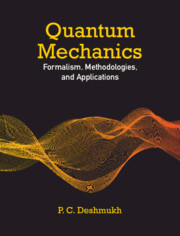Book contents
- Frontmatter
- Dedication
- Contents
- List of Figures
- Foreword
- Preface
- 1 Description of a Physical System
- 2 Path Integral Formulation of Quantum Mechanics
- 3 Probability Tangles and Eigenstates of One-dimensional Potentials
- 4 Angular Momentum
- 5 The Non-relativistic Hydrogen Atom
- 6 Approximation Methods
- 7 The Relativistic Hydrogen Atom
- 8 Quantum Mechanics of Spectral Transitions
- 9 The Many-Electron Atom
- 10 Quantum Collisions
- 11 Introduction to Quantum Information and Quantum Computing
- Appendix A Symmetry of the Hamiltonian
- Appendix B Schrödinger, Heisenberg, and Dirac “Pictures” of Quantum Dynamics
- Appendix C Spherical Harmonics
- Appendix D Occupation Number Formalism Second Quantization
- Appendix E Electron Structure Studies with Qubits
- Index
Appendix B - Schrödinger, Heisenberg, and Dirac “Pictures” of Quantum Dynamics
Published online by Cambridge University Press: 14 September 2023
- Frontmatter
- Dedication
- Contents
- List of Figures
- Foreword
- Preface
- 1 Description of a Physical System
- 2 Path Integral Formulation of Quantum Mechanics
- 3 Probability Tangles and Eigenstates of One-dimensional Potentials
- 4 Angular Momentum
- 5 The Non-relativistic Hydrogen Atom
- 6 Approximation Methods
- 7 The Relativistic Hydrogen Atom
- 8 Quantum Mechanics of Spectral Transitions
- 9 The Many-Electron Atom
- 10 Quantum Collisions
- 11 Introduction to Quantum Information and Quantum Computing
- Appendix A Symmetry of the Hamiltonian
- Appendix B Schrödinger, Heisenberg, and Dirac “Pictures” of Quantum Dynamics
- Appendix C Spherical Harmonics
- Appendix D Occupation Number Formalism Second Quantization
- Appendix E Electron Structure Studies with Qubits
- Index
Summary
A consistent description of the physical state of a system is provided by its wavefunction whose time-evolution is described by the Schrödinger equation
The wavefunction, is the coordinate representation of the state vector in the Hilbert space that describes the system. Unitary transformations of an orthonormal basis set that spans the Hilbert space amount to rotation of the basis set. An example of this is the unitary transformation from basis to using the Clebsch– Gordan coefficients that we discussed in Chapter 4. Such unitary transformations preserve the norm of the state vectors, and alternative basis sets connected by them provide mathematically equivalent descriptions of quantum mechanics. Preference of using one basis over another is dictated by algebraic elegance.
Alternative descriptions of the temporal evolution of a physical system are possible using generalized rotations that leave the physics invariant, but alter the description of the temporal evolution of the system. Whereas the Schrödinger picture describes temporal evolution of a physical system using methodologies in which the operators are independent of time, and all the time-dependence appears in the wavefunctions, in the Heisenberg picture all the time-dependence is contained in the operators, while the wavefunctions are considered independent of time. In the Dirac picture (also called as the Interaction picture), both the wavefunctions and the operators are considered to be time-dependent. The three pictures are essentially equivalent, and transformations from any one of them to any other are effected using generalized rotations brought about by unitary transformations described below.
The time-evolution operator in the Schrödinger picture is given by Eq. 1.86b (Chapter 1). If the reference time t0 is considered to be zero, the time evolution of a physical state is described by
where the exponential operator is
which gives the dynamical phase (Eq. 1.114b in Chapter 1) of a stationary state:
Operators like q, p, H are independent of time in the Schrödinger picture.
- Type
- Chapter
- Information
- Quantum MechanicsFormalism, Methodologies, and Applications, pp. 582 - 586Publisher: Cambridge University PressPrint publication year: 2024



